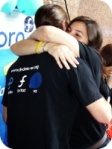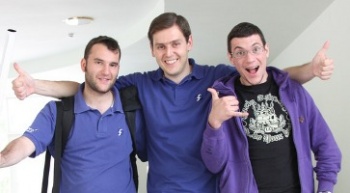m (→Developers) |
(Make a few changes, more coming) |
||
| Line 24: | Line 24: | ||
Fedora 13 (Goddard) is filled with improvements that make Linux better than ever for all types of users. Here are a few of the new things you can expect to see when you try out Fedora 13. | Fedora 13 (Goddard) is filled with improvements that make Linux better than ever for all types of users. Here are a few of the new things you can expect to see when you try out Fedora 13. | ||
===Desktop | ===Desktop users === | ||
{{admon/note|We need screenshots here!}} | {{admon/note|We need screenshots here!}} | ||
Easy | ==== Easy printing ==== | ||
{{admon/note|Rename feature to "easy print"?|Can we market it this way (I do think the name is more... explanatory for novice users than "automatic print driver installation")? I default to "yes, and make sure talking points contain both terms ("automatic print driver installation aka easy print") [[User:Mchua|Mel Chua]] 16:02, 27 April 2010 (UTC) | {{admon/note|Rename feature to "easy print"?|Can we market it this way (I do think the name is more... explanatory for novice users than "automatic print driver installation")? I default to "yes, and make sure talking points contain both terms ("automatic print driver installation aka easy print") [[User:Mchua|Mel Chua]] 16:02, 27 April 2010 (UTC) | ||
: I like "easy printing" without caps, so it's not so much like a brand name. --[[User:Pfrields|pfrields]] 23:34, 4 May 2010 (UTC)}} | |||
Color | Have you ever tried to use a new printer and been frustrated by constant error messages and an endless hunt for the correct driver to install? With the new easy printing feature in Fedora 13, you can simply plug your printer in and your computer will automatically find and install the correct driver. This feature allows you to print in many different locations and churn out copies within minutes. It's one of several innovations in Fedora 13 that let you take better advantage of your system's hardware. | ||
==== Color management ==== | |||
{{admon/note|Needs to be finished.|Can someone polish up this description - preferably someone who can write it in a way attractive to publishers/illustraters/etc? Also, this is a GREAT thing to screenshot.}} | {{admon/note|Needs to be finished.|Can someone polish up this description - preferably someone who can write it in a way attractive to publishers/illustraters/etc? Also, this is a GREAT thing to screenshot.}} | ||
Revision as of 23:34, 4 May 2010
Fedora is a Linux-based operating system that brings the latest in free and open source software to your desktop, laptop and server. This allows you to run many different open source applications. Using Linux, you are able to find a piece of free software for virtually anything and run it on Fedora. This helpful, user-friendly operating system is built by people across the globe who work together as a community, to create the the Fedora Project.
 |
 |
 |
 |

|
Fedora is free to use, modify, and distribute, and includes software that helps you work, play, organize, and socialize. You can read more information about the Fedora Project on our Overview page.
File:F13-relnotes-screenshot-main.png
What's new in Fedora 13?
Fedora 13 (Goddard) is filled with improvements that make Linux better than ever for all types of users. Here are a few of the new things you can expect to see when you try out Fedora 13.
Desktop users
Easy printing
Have you ever tried to use a new printer and been frustrated by constant error messages and an endless hunt for the correct driver to install? With the new easy printing feature in Fedora 13, you can simply plug your printer in and your computer will automatically find and install the correct driver. This feature allows you to print in many different locations and churn out copies within minutes. It's one of several innovations in Fedora 13 that let you take better advantage of your system's hardware.
Color management
Color management helps artists, photographers, and designers to display and print their work more accurately by using 100% free software. The color management helps you control and produce more accurate color outputs for displays, printers, and scanners.(This seems kinda vague... can we dig for more details to make it more specific? What features would someone like Darren care about knowing here?) True color workflow for illustrators, designers, photographers, publishers, creators of all skill levels --pfrields 14:28, 16 April 2010 (UTC)
Video Drivers
Fedora and its sponsor Red Hat are dedicated to improving the quality and coverage of completely free, accelerated video drivers. We recognize that the vendors' drivers sometimes conflict with and cause problems in the software written by open source community members. Not only that, since they aren't free and open source, we can't help fix those problems. Fedora 13 includes free drivers for most of the major cards like NVidia, ATI, and Intel that even give you 3D acceleration for an exciting desktop experience. And we'll keep improving those drivers in future releases so you can enjoy the best in free software.
System Administrators
If you spend your day managing how other people around you use Linux, Fedora 13 is loaded with features that will make your life even easier. Whether your requirements lie in migrating new users to a Linux environment, testing out the shiniest, newest versions of Fedora, or you want to experiment with the newest in open-source technologies to give yourself an edge -- Fedora has all the tools you need. The best part? They're all free, open-source software -- just one more thing you can impress the boss with.
boot.fedoraproject.org
boot.fedoraproject.org (BFO) is a unique feature in Fedora. It allows users to download a single, tiny image and install current and future versions of Fedora, without having to download additional images.
What is SSSD and its purpose?
System Security Services Daemon (SSSD) is a progressive new software that provides expanded features for logging into managed domains, including caching for offline authentication. This means that, for example, users on laptops can still login when disconnected from the company's managed network.
Developers
Software developers will find that the Fedora 13 release expands SystemTap's introspection capabilities beyond the kernel to give programers visibility into what is happening inside user space applications and language runtimes like Java, Python and TCL.
Python developers in particular will find dual-language backtraces - a Python feature originating in Fedora and making its way into the Python language upstream - a big assist when debugging mixed-language libraries (for instance, Python and C/C++). Fedora 13 also blazes a trail with a parallel-installable Python 3 stack that will help programmers write and test code for use in both Python 2.6 and Python 3 environments.
For Java programmers, Fedora 13 also features version 6.8 of the NetBeans IDE, the first to offer complete support for the entire Java EE 6 spec with improved support for JSF 2.0/Facelets, Java Persistence 2.0, and EJB 3.1. And of course Fedora's package ecosystem is rich with thousands of other tools for a myriad of languages and development styles; after all, we use it for development ourselves.
Spins
Spins are more specialized versions of Fedora that allow you to run programs that suit your interests. For example:
Got a netbook?
Try the Moblin Spin! A version of Fedora featuring the Moblin Architecture. Everything from application choice to screen resolution has been designed to support multiple platforms and usage models -- ranging from Netbooks and NetTops to Mobile Internet Devices and various embedded usage models.
Know a curious kid?
Try the Sugar on a Stick spin! Designed to be uploaded to flash drives and used in various places on different computers (as if it were on a stick), this Fedora spin features the award-winning Sugar Learning Platform. Originally developed for the One Laptop Per Child project, Sugar is used every school day by one million children in more than forty countries. Students can take their stick to any machine running any operating system -- at school, at home, at a local library or community center -- and boot their custom Sugar environment without touching any files on the host machine, bringing personalized computing within the reach of any child with a thumbdrive.
Feeling artistic?
The Fedora Design Suite was constructed for designers, by designers. This features the tools the Fedora Design Team uses on a daily basis to create wallpapers, icons, and interfaces that you see in Fedora. This spin includes everything from document layouts, to vector and bitmap graphics, to 3D modeling. It allows a wide range of projects to be created.
Learning about computer security?
The Fedora Security Spin is an environment designed by and for computer security professors and professionals. With applications for everything from security auditing and forensics, to penetration testing and intrusion detection, it is an ideal tool for the classroom or the sysadmin's kit for diagnosing and rescuing broken computers.
Looking for something else?
Find more spins at http://spins.fedoraproject.org/ -- there's a spin for everyone, from education and gaming to science and more!
How to get started
Intrigued? Want to give Fedora 13 a try?
You can visit http://fedoraproject.org/get-fedora to download a LiveCD, regardless of what operating system you're running. This will give you a working version of Fedora, complete with common applications, all running off your CD drive - your hard drive won't be touched at all. And when you're ready, installation is just a click away.
And if you're running Fedora 12, upgrading is easy. Refer to our handy documentation for help. (Note: we need to update that link to an f13 upgrade documentation link. Should likely be the same link - but sub f13 for f12. --Rbergero 23:58, 29 April 2010 (UTC))
Help make Fedora!
 |
Want to join the Fedora community and help us make the best Linux distribution even better? Get started at http://fedoraproject.org/wiki/Join. Our diverse community from all over the globe welcomes contributors of all types. From artists to marketers to coders to testers to writers to translators and more, you too can get involved. Share what you know or help with something you've always wanted to learn; mentors are always available to help you get started. Any help is appreciated!
We'd love to hear your thoughts on Fedora 13. Have a suggestion? Find a bug? Start by taking a look at the Common F13 bugs to see if it's something we know about. (That page has information on what to do if you don't find your bug, too.) |
Further reading
Want more? Here are some further resources on Fedora 13, or talk with a community member in our live chat 24/7.
- Fedora 13 release announcement (http://fedoraproject.org/wiki/Fedora_13_Announcement)
- Fedora Overview (http://fedoraproject.org/wiki/Overview)
- Fedora FAQ (http://fedoraproject.org/wiki/FAQ)
- Help and Discussions (http://fedoraproject.org/wiki/Communicate)
- Fedora 13 release notes (http://docs.fedoraproject.org/release-notes/)
- Fedora 13 feature profiles (http://fedoraproject.org/wiki/F13_feature_profiles)
- Fedora 13 talking points (http://fedoraproject.org/wiki/Fedora_13_Talking_Points)
- Common Fedora 13 Bugs (http://fedoraproject.org/wiki/Common_F13_bugs)
About this document
- LINK TO PDF/SVG versions
- Translations of this document are also available - if you make a translation, please link to it from this list!
- TRANSLATION
- TRANSLATION

